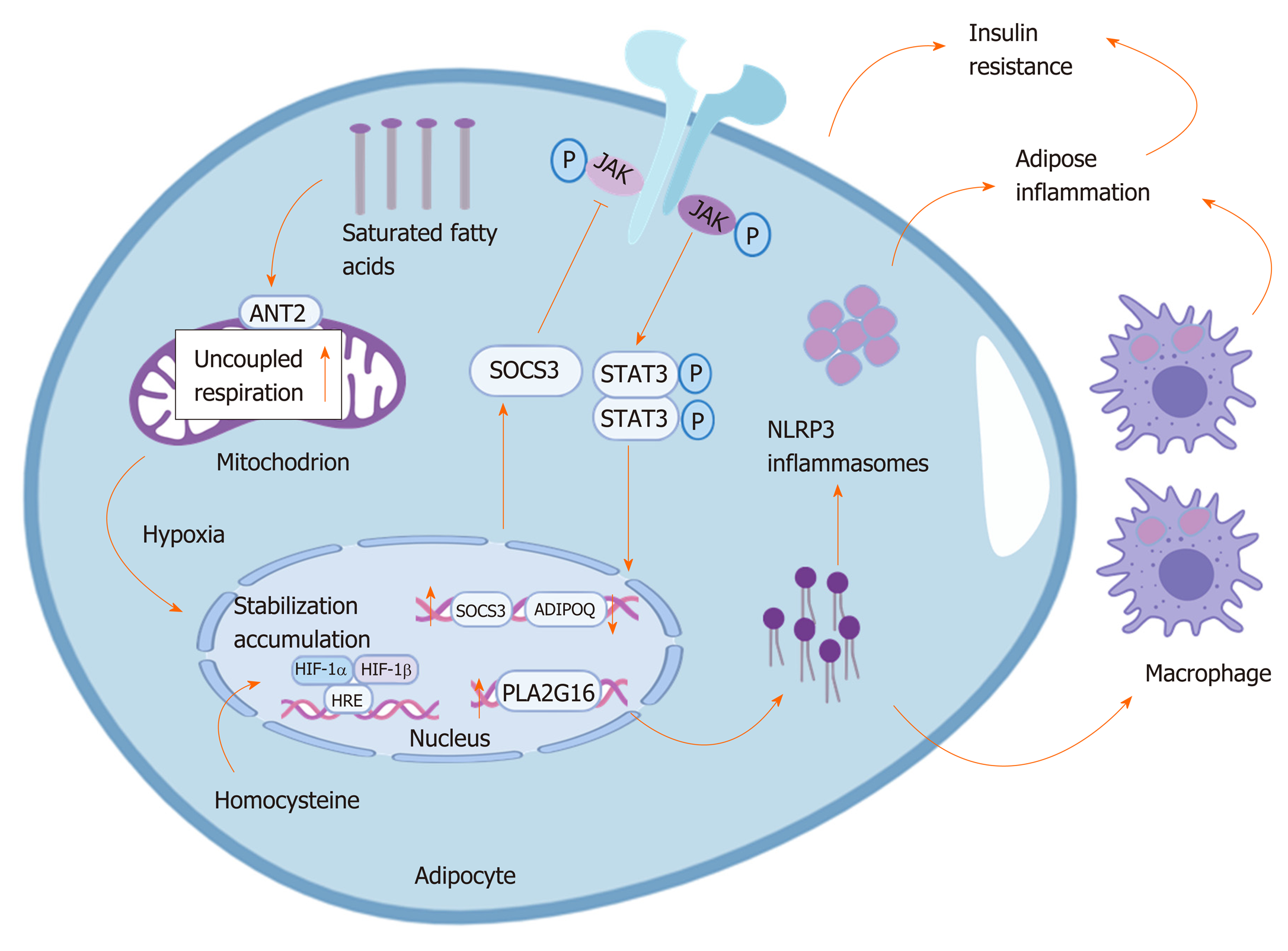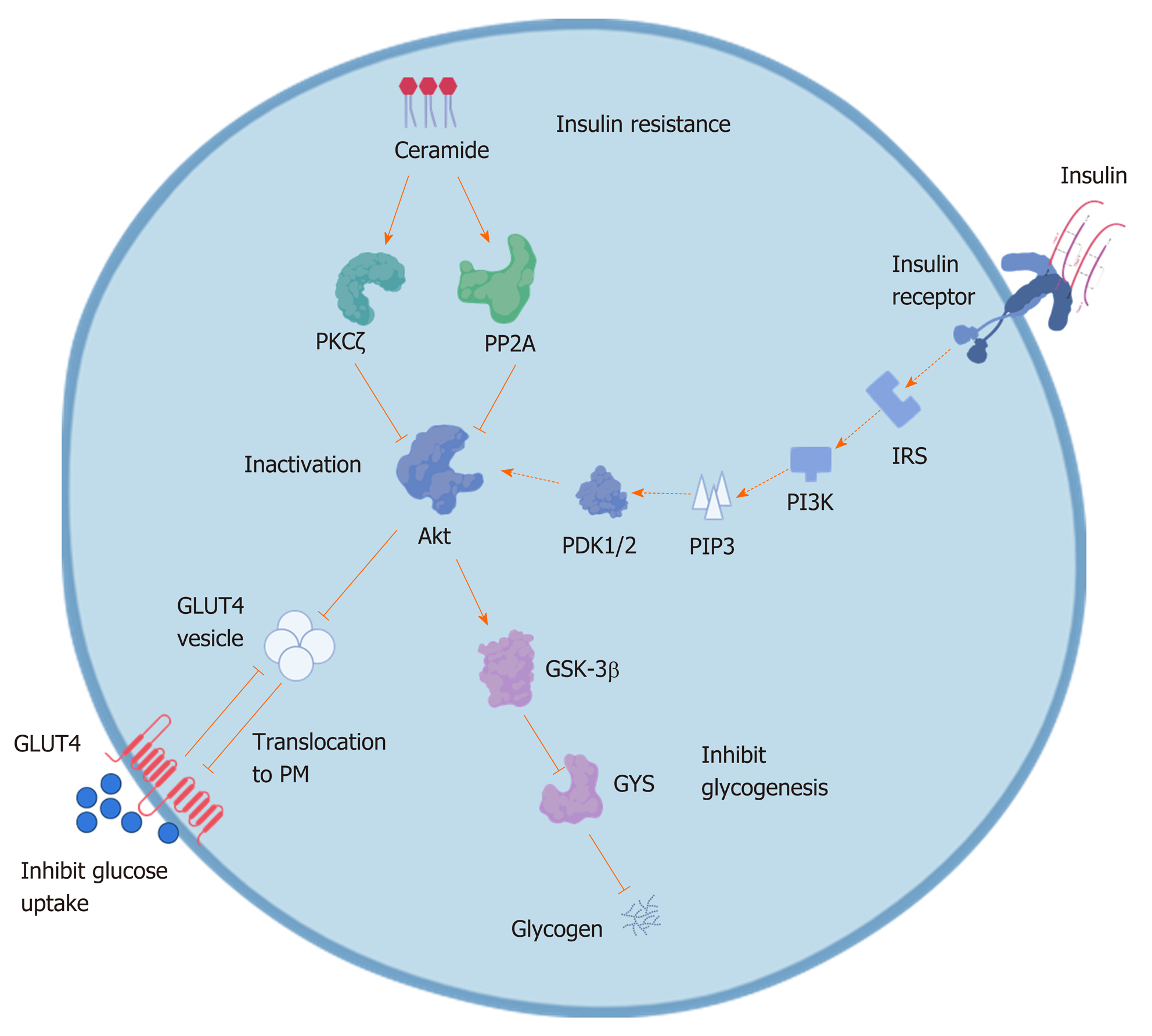Copyright
©The Author(s) 2020.
World J Gastroenterol. May 14, 2020; 26(18): 2177-2186
Published online May 14, 2020. doi: 10.3748/wjg.v26.i18.2177
Published online May 14, 2020. doi: 10.3748/wjg.v26.i18.2177
Figure 1 Accumulation of hypoxia-inducible factor 1α induces insulin resistance in hypoxic adipocytes.
Owing to excess saturated fatty acids binding to adenosine diphosphate/adenosine-triphosphate translocase 2 in mitochondria, which increases uncoupled respiration leading to hypoxia in adipose tissue, the stabilized and accumulated hypoxia-inducible factor 1α (HIF-1α) further regulates relative target genes. On the one hand, HIF-1α induces expression of suppressor of cytokine signalling 3, which in turn activates signal transducer and activator of transcription 3, and dimerized signal transducer and activator of transcription 3 enters the cell nucleus and inhibits the transcription of ADIPOQ, resulting in insulin resistance. On the other hand, HIF-1α up-regulates the expression of pla2g16 to increase the level of lyso-PC, which in turn activates NLRP3 inflammasomes and stimulates NLRP3 inflammasomes in macrophages of adipose tissue, promoting insulin resistance. ANT2: Adenosine diphosphate/adenosine-triphosphate translocase 2; HIF-1α: Hypoxia-inducible factor 1α; SOCS3: Suppressor of cytokine signalling 3; JAK: Janus kinase; STAT3: Signal transducer and activator of transcription 3; HRE: Hypoxia-inducible factor regulating element; P: Phosphate; lyso-PC: Lyso-phosphatidylcholine.
Figure 2 Ceramide synthesis pathways.
Ceramides are synthesize through three ways, namely, de novo pathway, salvage pathway, and sphingomyelinase pathway. The de novo synthesis of ceramide commences with the condensation of serine and palmitate via action of serine palmitoyl-coenzyme A acyltransferase, followed by the continuous action of 3-keto-dihydrosphingosine reductase, dihydroceramide synthases, and dihydroceramide desaturase. In the sphingomyelinase pathway, ceramide can be produced from hydrolysis of sphingomyelin through the action of either acid or neutral sphingomyelinase, and ceramide also can synthesize sphingomyelin through the action of sphingomyelin synthase. The salvage pathway is more complex than the other two pathways. Glucosylceramide, complex sphingolipids, sphingosine, and sphingomyelin can generate ceramide from the action of diverse enzymes such as glucosylceramide synthase, LASS, and sphingomyelinase. SPT: Serine palmitoyl-coenzyme A acyltransferase; SMase: Sphingomyelinase; GCS: Glucosylceramide synthase.
Figure 3 The mechanism of ceramide inducing insulin resistance.
Ceramide inactivates protein kinase B (Akt) through stimulating the activity of protein kinase Cç isoform and protein phosphatase 2A which phosphorylates and inhibits the translocation of Akt. The inactivation of Akt prevents from translocation of glucosetransporter4 vesicle to plasma membrane, resulting in inhibiting glucose uptake. Simultaneously, inactivated Akt in turn activates glycogen synthase 3, leading to inactivation of glycogen synthase and thus inhibition of glycogen synthesis and resulting in insulin resistance. PKB: Protein kinase B; PKCç: Protein kinase Cç; PP2A: Protein phosphatase 2A; GLUT4: Glucosetransporter4; PM: Plasma membrane; GSK-3: Glycogen synthase 3; GYS: Glycogen synthase; IRS: Insulin receptor substrate; PI-3K: Phosphoinositide 3-kinase; PIP3: Phosphatidylinositol-3,4,5-trisphosphate; PDK1/2: 3-phosphoinositide-dependent protein kinase 1/2.
- Citation: Xia QS, Lu FE, Wu F, Huang ZY, Dong H, Xu LJ, Gong J. New role for ceramide in hypoxia and insulin resistance. World J Gastroenterol 2020; 26(18): 2177-2186
- URL: https://www.wjgnet.com/1007-9327/full/v26/i18/2177.htm
- DOI: https://dx.doi.org/10.3748/wjg.v26.i18.2177















